While you’ll see a lot of road kill on the UK’s roads, like badgers, stoats and the occasional deer, drivers in other countries have to contend with different wildlife, some of it as big as a car. Check out these road signs from Australia and New Zealand. Maybe one day you’ll visit there and drive on their roads.
Both Australia and New Zealand drive on the left hand side, like in the UK.
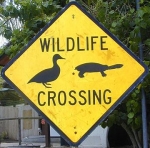 |
Ducks have absolutely no road sense, and turtles are really slow. You’ll find signs like this especially in Northern Queensland where you can see turtles basking on rocks around rivers and streams. |
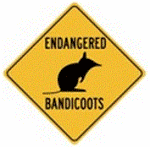 |
While most of Australia’s native wildlife looks much like different sized rats with a marsupial pouch, bandicoots are endearingly cute, coming out at night to find food. I watched a couple of them for a good 10 minutes while staying at Kingfisher Park in Julatten, Queensland. |
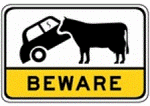 |
With huge unfenced ranches in outback Australia, livestock is able to wander onto roads. A cow will make a serious mess of your vehicle if you hit it, even though they do look way more scrawny than their UK counterparts. |
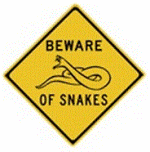 |
Snakes are known to bask on the warm tarmac near the end of the day and they’re hard to see. Also, seeing as Australia is packed to the gills with snakes that are the most poisonous in the world, these signs remind walkers and cyclists to be careful, too. |
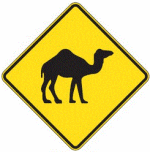 |
Camels were brought to Australia to help with lugging loads. Now they’re a feral pest in the deserts and outback. You’ll probably not spot one, but if you hit one with your car, you’ll definitely have the hump. |
 |
Where there are camels there are often kangaroos, wallabies and wombats. Kangaroos can be surprisingly big – taller than a man. Wombats are like furry armoured personnel carries and will cause quite a lot of damage. Wallabies are smaller and more difficult to see, particularly ones like the pretty-faced wallaby which are supremely camouflaged. On a long drive from Cooktown to Daintree approaching dusk there were hundreds of kangaroos and wallabies in the long grass by the side of the road, and there’s plenty of road kill evidence.Trucks and road trains often have roo bars to protect the front of them. |
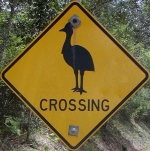 |
Cassowaries are a large rare bird that lives primarily in the rainforests in Queensland. Many people never see one alive in the wild as there are only around 1500 left. I was fortunate to see a male and two juveniles drinking at a stream. The Cassowary is as tall as a man, and a dangerous bird in the wild as it has a large claw on each foot like a velociraptor. Slow down when you see these signs because Queensland can’t afford to lose any more of them to vehicle accidents. |
 |
Another cassowary sign reminds drivers to slow down, and that they are big and heavy objects to run into. |
 |
Penguins are found in Australia and New Zealand, but this sign is from Australia where they might be hanging out under your car. |
 |
Dingoes are sandy-coloured wild dogs that live in the outback. |
 |
This is a generic road sign to indicate there are waterbirds around, which could be ducks, geese or swans. |
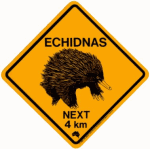 |
Echidnas – I’ve never seen one in the wild, but they’re like a snuffly little hedgehog. They’re actually a type of anteater and feed off the abundant termites and ants. You’ll find them in many places in Australia, including cities. |
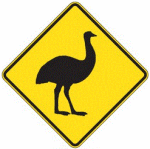 |
Emus are another large bird found in Australia. They’re not as big as a cassowary, but still represent quite a lump if struck by a car. The risk is that if you do hit one, the car takes the legs from under the bird and then you have the big mass of body that’s likely to smash your windscreen. Obviously, motorbikes are particularly vulnerable. |
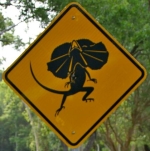 |
Frilled lizards are not particularly common on the road, or big. Still, it’s good to know they are around so you don’t inadvertently run over one. You’re more likely to see a range of different lizards. |
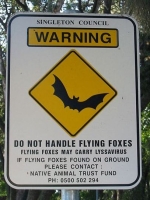 |
Flying foxes are a large bat. The main danger to your car is if you park under a tree where they are roosting because you’ll come back to it covered in stinky bat guano. They tend not to fly at car height as they take off from the trees where they quite often roost in urban areas and head into the forest to feed, so it’s unlikely you’ll run into one. |
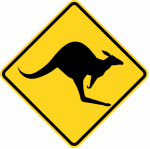 |
A generic road sign for kangaroos and wallabies. |
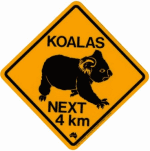 |
Koalas are becoming more endangered, but you’ll still find them in some urban areas. While we think of them as being tree-bound, they do move between trees by running along the ground. |
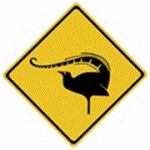 |
Lyrebirds are ground-dwelling birds. They’re mainly found in New South Wales and South Queensland. |
 |
Platypus are cat-sized aquatic mammals. They come out at dusk and feed in rivers and streams. It’s unlikely you’ll see them on the roads because it’s difficult enough to find them even in the wild, but be careful around their habitats. |
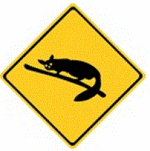 |
Possums are found in Australia and New Zealand. In New Zealand you will never see this sign because they are an introduced pest. In Australia they are more endangered. You will often see them on the side of the road in New Zealand, with plenty of road kill examples. I have not seen one in Australia. |
 |
Generic wildlife sign indicating a water bird. |
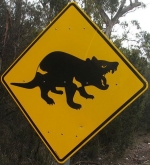 |
You’ll only see this sign in Tasmania as it’s the Tasmanian Devil which is a small mammal. |
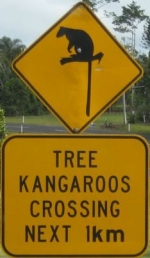 |
Tree kangaroos are found in Northern Queensland. I have tried to see them in the wild in Australia and not succeeded. They’re not that big – around 40-70cm. |
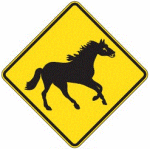 |
Wild horses can be a danger in Australia and New Zealand. This is an Australian sign. In New Zealand wild horses are found in the Kaimanawa Ranges. |
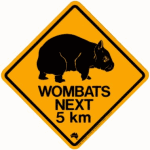 |
Wombats are big, chunky mammals. They’ll do some damage if you run into one. |
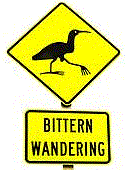 |
Bitterns are rare waterbirds found in New Zealand. I have been out looking for them in the wetlands and never seen one. Because they’re rare, it’s better if you don’t kill one with your vehicle. |
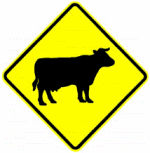 |
New Zealand has way more cows than humans. While the farms are fenced, farmers often move livestock between paddocks and that requires they cross roads. |
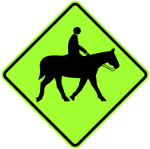 |
Recreational horse riding is common in New Zealand. Also, in some parts of the country, such as the East Cape, you’ll frequently see people using horses and not cars. |
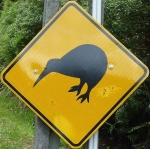 |
The kiwi is the iconic bird of New Zealand. It is rare and nocturnal. |
 |
Another kiwi sign. |
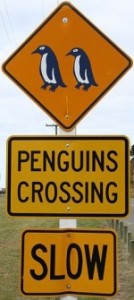 |
Little blue penguins are common around the coast of the North Island of New Zealand. |
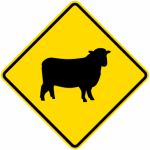 |
Sheep are the other large farm animal that is abundant in New Zealand. There are millions of them. Generally they are fenced off, but they sometimes escape. |
